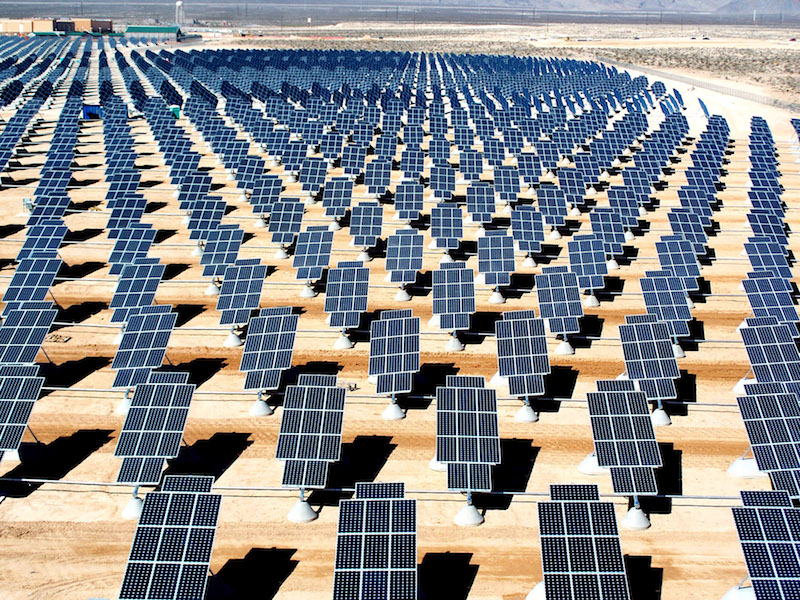Carbon dioxide has become far too prevalent in our atmosphere and is a large component of greenhouse gases that many believe are responsible for climate change. But what if this excess carbon dioxide could be harvested from the atmosphere, repurposed, and used to make a clean, renewable energy source that already exists more efficient?
It sounds like a plan Doc Brown would have concocted and then hurriedly told Marty McFly about as a group of angry terrorists bared down on them, but this isn’t the stuff of science fiction like a flux capacitor, this is very much based in reality.
GE believes it has found a way to harvest CO2 and use it to create solar batteries, Digitaltrends.com reports. Solar energy is a great source of renewable energy, but there is a problem: the sun needs to be shining in order to harness its power. Currently, there isn’t a very efficient means of storing energy produced from solar power to keep it available to the grid whenever it is needed, even if the sun isn’t currently shining, but that could all change.
Here is how the two-stage process works: solar energy would be captured and stored in a liquid of molten salt. Harvested and stored CO2 would then be cooled into dry ice and, when power is needed, the salt would turn the dry ice CO2 into a “supercritical” fluid (which is defined as matter that does not have specific liquid or gas phases). This supercritical fluid would then flow into a CO2 turbine called a sunrotor and the energy would be disseminated as needed.
If it seems complicated, well, that’s probably because it is. But don’t worry, just because something being complicated often times means it is inefficient and/or expensive, that isn’t the case here.
Not only would the process be cheap since energy isn’t being made, just transferred, the sunrotors would also be able to operate with 68% efficiency. Gas power plants are typically only able to achieve 61% efficiency.
However, this process and the sunrotors are still a good five to 10 years away from actually being put into use, but the fact that the technology exists to not only suck some CO2 out of the atmosphere but to also use it to make renewable, clean energy sources more efficient and practical makes this a classic two birds with one stone scenario.
The overall effect of these sunrotors and this CO2 harvesting/storing process is reduced usage of fossil fuels for power generation, which would only work to eliminate even more CO2 from the atmosphere.
Related Stories
Sustainability | Jul 27, 2023
USGBC warns against building energy code preemptions, rollbacks
In a recent editorial, the USGBC cited a growing number of U.S. state legislators who are “aiming to roll back building energy code standards and/or preempt local governments from advancing energy-efficient building codes.”
Resiliency | Jul 27, 2023
'Underground climate change' can damage building foundations, civil infrastructure
A phenomenon known as “underground climate change” can lead to damage of building foundations and civil infrastructure, according to a researcher at Northwestern University. When the ground gets hotter, it can expand and contract, causing foundations to move and sometimes crack.
Sustainability | Jul 19, 2023
California lawmakers approve governor’s plan to accelerate green construction
California lawmakers recently approved Gov. Gavin Newsom’s infrastructure streamlining plan that aims to accelerate clean energy and infrastructure projects.
Sustainability | Jul 13, 2023
Deep green retrofits: Updating old buildings to new sustainability standards
HOK’s David Weatherhead and Atenor’s Eoin Conroy discuss the challenges and opportunities of refurbishing old buildings to meet modern-day sustainability standards.
Mass Timber | Jul 11, 2023
5 solutions to acoustic issues in mass timber buildings
For all its advantages, mass timber also has a less-heralded quality: its acoustic challenges. Exposed wood ceilings and floors have led to issues with excessive noise. Mass timber experts offer practical solutions to the top five acoustic issues in mass timber buildings.
Codes | Jul 10, 2023
Water Demand Calculator outperforms traditional plumbing codes for energy, carbon, and water savings
Using IAPMO’s Water Demand Calculator tool can result in energy, carbon, and water savings as compared to using traditional plumbing specification methods in plumbing codes, according to a study by Arup.
Contractors | Jun 30, 2023
Construction industry task force aims for standardized carbon reporting
A newly formed Associated General Contractors of America (AGC) task force on decarbonization and carbon reporting will address the challenges around reporting and reducing carbon emissions in the construction industry.
Apartments | Jun 27, 2023
Dallas high-rise multifamily tower is first in state to receive WELL Gold certification
HALL Arts Residences, 28-story luxury residential high-rise in the Dallas Arts District, recently became the first high-rise multifamily tower in Texas to receive WELL Gold Certification, a designation issued by the International WELL Building Institute. The HKS-designed condominium tower was designed with numerous wellness details.
Green | Jun 26, 2023
Federal government will spend $30 million on novel green building technologies
The U.S. General Services Administration (GSA), and the U.S. Department of Energy (DOE) will invest $30 million from the Inflation Reduction Act to increase the sustainability of federal buildings by testing novel technologies. The vehicle for that effort, the Green Proving Ground (GPG) program, will invest in American-made technologies to help increase federal electric vehicle supply equipment, protect air quality, reduce climate pollution, and enhance building performance.
Industrial Facilities | Jun 20, 2023
A new study presses for measuring embodied carbon in industrial buildings
The embodied carbon (EC) intensity in core and shell industrial buildings in the U.S. averages 23.0 kilograms per sf, according to a recent analysis of 26 whole building life-cycle assessments. That means a 300,000-sf warehouse would emit 6,890 megatons of carbon over its lifespan, or the equivalent of the carbon emitted by 1,530 gas-powered cars driven for one year. Those sobering estimates come from a new benchmark study, “Embodied Carbon U.S. Industrial Real Estate.”

















